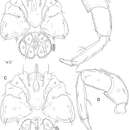Hygrobates: Brief Summary
(
anglais
)
fourni par wikipedia EN
Hygrobates is a genus of mites belonging to the family Hygrobatidae.
The genus has cosmopolitan distribution.
Species:
Hygrobates acutidens Viets
Hygrobates acutipalpis
- licence
- cc-by-sa-3.0
- droit d’auteur
- Wikipedia authors and editors
Description
(
anglais
)
fourni par Zookeys
General features: Integument lineated, occassionaly lines formed as irregular ridges (Fig. 2C). Posteromedial margin of Cx-I slightly triangular, Cx-IV medial margin nose-like protruding. Acetabula arranged in an obtuse triangle; excretory pore unsclerotized, distance genital field – excretory pore L in male 110-241, in female 280-351. Palp: P-2 ventral margin straight, distally forming a right angle, denticles covering two-thirds of the ventral margin of both P-2 and P-3; P-4 ventral setae on the same level.
Male (holotype, in parentheses measurements of paratype, n = 5): Idiosoma L/W 960/810 (720–1115/645–940); coxal field (Fig. 1A) L/W 516/680 (495–612/600–745), median length of Cx-I + gnathosoma 395 (380–450); genital plate (Figs 1A, 2A) L/W 261/340 (210–285/315–380), gonopore L 137 (108–130), L Ac-1–3: 107 (102–112), 145 (140–150), 121 (115–125); anterior margin with a small, knob-shaped medial projection, posterior margin indented, with a short, rounded medial projection. Distance between genital field and excretory pore L 200 (110–241). Palp (Fig. 1B, 2F) total L 621 (586–665), dL: P-1, 40 (36–48); P-2, 157 (146–170); P-3, 136 (128–140); P-4, 218 (208–235); P-5, 70 (68–72). Chelicera L 487 (440–496), claw L 170 (157–172). Legs: dL of I-L-4–6: 257 (250–270), 266 (258–275), 243 (235–258); dL of IV-L-4–6: 391 (365–410), 397 (382–422), 346 (325–368).
Female (n = 5): Idiosoma L/W 720–1507/540–1250; coxal field (Fig. 1C) L/W 495–610/550–847; median length of Cx-I + gnathosoma 400–460. Palp (Figs 1D, 2I) total L 668–749, dL: P-1, 47–51; P-2, 160–198; P-3, 144–160; P-4, 241–262; P-5, 78–80. Chelicera L 490–548, claw L 170–190. Genital field (Fig. 1C, 2B) W 330–418, genital plate L 230–268, genital opening L 210–280, L Ac-1–3: 110–120, 145–150, 126–130. Legs: dL of I-L-4–6 285–302, 295–310, 267–286; dL of IV-L-4–6: 430–456, 440–460, 361–385.
- licence
- cc-by-3.0
- droit d’auteur
- Yunus Esen, Vladimir Pešić, Orhan Erman, Yücel Kaya
- citation bibliographique
- Esen Y, Pešić V, Erman O, Kaya Y (2013) New water mites of the family Hygrobatidae (Acari, Hydrachnidia) from Turkey ZooKeys 361: 15–25
- auteur
- Yunus Esen
- auteur
- Vladimir Pešić
- auteur
- Orhan Erman
- auteur
- Yücel Kaya
Distribution
(
anglais
)
fourni par Zookeys
Known only from the type locality in Kahramanmaraş Province, Turkey.
- licence
- cc-by-3.0
- droit d’auteur
- Yunus Esen, Vladimir Pešić, Orhan Erman, Yücel Kaya
- citation bibliographique
- Esen Y, Pešić V, Erman O, Kaya Y (2013) New water mites of the family Hygrobatidae (Acari, Hydrachnidia) from Turkey ZooKeys 361: 15–25
- auteur
- Yunus Esen
- auteur
- Vladimir Pešić
- auteur
- Orhan Erman
- auteur
- Yücel Kaya

